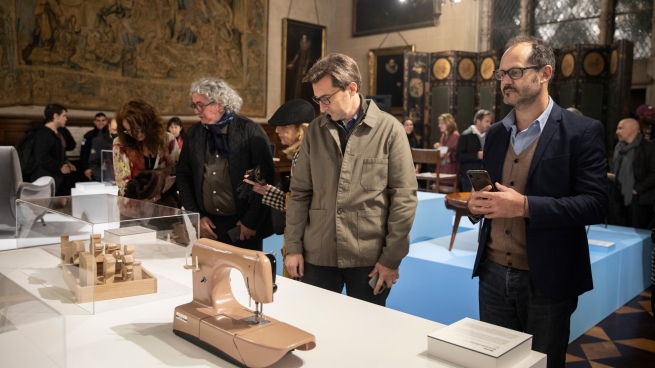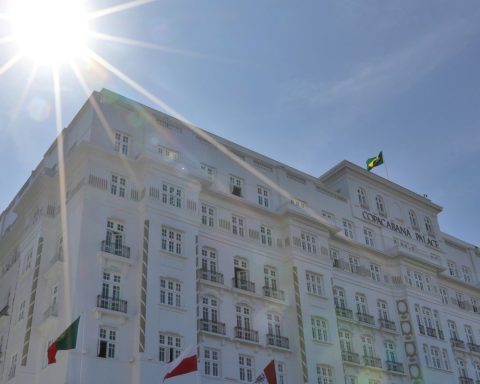Coffee makers, armchairs, lamps, vases, chairs and portable typewriters such as the unforgettable Lettera 22 are part of the “Italian Design” exhibition presented at the National Museum of Decorative Art until January 29, where the milestones of Italian creativity that go from the post-war to the present establish a dialogue between designs from both countries, as well as give rise to the emotions that arise before those everyday objects that transcend the utilitarian and touch hidden regards.
Under the title “Italian design. The beauty of everyday life between Italy and Argentina”the exhibition curated by an architect and design specialist, the Italian Silvana Annicchiaricois housed in four of the museum’s rooms until the end of January and is organized by the Italian Institute of Culture of Buenos Aires under the general coordination of its director, Donatella Cannovanext to the national museum founded in 1937.
“The objects that can be seen in the exhibition have taught the history of how Italian industrial design has developed, and when it is said Italian we can say in the world because there are objects such as the famous Lettera 22, the typewriter that all of us one way or another we have seen in our homes, which are iconic and well-known objects all over the world precisely because they respond and change habits and customs”, says Cannova in dialogue with Télam.
Precisely the Lettera 22, Olivetti’s portable typewriter created by Marcello Nizzoli and Giuseppe Beccio in 1950, opens a tour in the great hall of the palace that invites you to stop at each of the pieces, appreciate them and read the precise explanation that contextualizes a way of using and feeling objects that represent shared stories.

Armchairs, chairs, coat racks, shelves, stackable containers, armchairs, radios, televisions, typewriters, lamps, coffee pots, vases, juicers, clocks, radios, fans, among other utilities, give account of a history of materials and uses, in a single space on display whose assembly design was in charge of Bruno Morello.
The exhibition, which exhibits numerous italian industrial design objects in a chronology that marks different historical milestones from the postwar period to the present dayin turn dialogues with others of national production in a counterpoint that allows us to find similarities and differences.
The transit of an Italy that emerges defeated from the Second World War and establishes itself as a powerful industrial country, although permeable to the globalized historical evolution, marks a special way of conceiving design in a democratizing role.

“Design has accompanied Italy on the long journey that has led the country to enter modernity and become one of the greatest industrial and manufacturing powers in the world. Since the post-war period, it has played a democratizing role by offering functional and concrete responses to the social and individual needs that were maturing. It has improved daily life, the quality of life, the comfort of the houses, the possibilities of movement and communication. Above all, it gave substance to the dream of bringing beauty to everyone’s life without distinctions of class and culture,” explains Annicchiarico.
“In Italy, design was the direct heir to that great tradition of material culture that comes from afar, at least from the craft and creative workshops of our renaissance,” says the curator. And he maintains: “Argentina is a land that has welcomed many Italian migrants, who have brought with them the inspiration and creativity inherent in Italianity. That is why between Italian and Argentine design there are not only many hinge-figures such as those of (Emilio) Ambasz, Tomás (Maldonado) and Paolo (Bergomi), but also affinities and analogies in the respective paths of search and design”.
Cannova, for his part, points out that this year the cultural institution that directs “the great Italian exhibitions in cultural spaces of Buenos Aires in collaboration with the National Ministry of Culture” resumed this year, just as last year they presented the splendid exhibition in Technopolis of the “Virgins of Raphael”.
On this occasion, Annicchiarico was invited as an expert in design, “who has curated exhibitions in Italy and abroad and directed the Design Museum of the Milan Triennale” (2007-2018) and who she catalogs as “an absolute reference” in the topic.

“The Italian Institute of Culture of Buenos Aires wanted precisely to resume the great Italian exhibitions and it seemed to us that returning to the materiality of the objects that embellish existence, after so much virtuality that we have experienced these two years of pandemic, was a way to honor so many creators, so much industry, so much ability to respond from the functional to the needs we have in everyday life”, explains Cannova.
“For Italian culture, design represents a territory where creativity, business culture, the ability of an entire artisanal production system that concerns the ability to fine-tune prototypes and then the transition to mass production are found. This combined flexibility is one of the main features of the Italian design system’s ability to respond to the needs of all of us.”
But there is a dimension that transcends utility and that is the emotion that is reflected in these “objects that have also interpreted dreams”, as the curator said at the opening.
“I believe that the greatness of Italian design lies in the fact that it has not limited itself to providing concrete answers to existing needs, but has always been capable of looking beyond, of being visionary and clairvoyant. It has captured not only the needs but also the dreams that crowded the collective imagination. It has given them sap and energy”, indicates Annicchiarico.
“From a certain moment, designers such as Ettore Sottsass or Gaetano Pesce have made artifacts that brought into everyday life not only a functional response to an empirical problem, but also emotions.” Therefore, “design has loaded its artifacts with a very strong emotional power, and has made certain objects end up being essential in defining the identity of whoever used them,” concludes Annicchiarico.
The chronological route traces an “evolutionary” line in the history of Italian design in five great moments in the contemporary history of the European country and brings together pieces by great designers such as Gio Ponti, Ettore Sottsass, Michele De Lucchi, Vico Magistretti, Bruno Munari, Gaetano Pesce, Marco Zanuso and Antonio Citterio, among others.
In the selection of pieces are the iconic Pipistrello lamp by Gae Aulenti, the Proust armchair by Alessandro Mendini or the “Napoletana” coffee maker by Riccardo Dalisi, the portable radio by Zanuso and Richard Zapper (1964), or Cactus, a coat rack that officiates of sculpture with its intense green created by Franco Mello and Guido Drocco (1972), among other designs that play and investigate the innovation of materials and configure a way of living.
Although “Primates” (2017), polychrome vases designed by Elena Salmistraro or the children’s game “16 animali” by Enzo Mari (1957), Joe Colombo’s “Smoke” glasses, corkscrews “Anna G.” (1994) by Cavatappi and Alessandro Mendini, or in an ecstatic red the Tatlin seat (1989) by Mario Cananzi and Roberto Semprini inspired by the constructivist tower by Vladimir Tatlin, or the “Superwave” (1967), “one of the most provokers of rebellion against the establishment and the good design of the Archizoom Associati that can be used as a “divan, armchair, support base or sculpture”, among others.

A peculiarity of this design exhibition is the coexistence with paintings, tapestries, statues, furniture and other objects from the palace itselfwhich are placed as embracing this sample of 58 Italian design objects and 20 Argentine pieces belonging to the collection of the Museum of Modern Art in Buenos Aires, in a kind of expanded dialogue.
Among the Argentine designs, placed alongside the Italian ones, are “Blue Towers” (1969) by the “pop” designer Edgardo Giménez, the “Alunizaje” chair by Guillermo Eirin and Horacio Baliero with his “La Compañía”, a wicker and iron. Also the S522 chair created for Harpa by Leonardo Aizemberg and José Luis Pastor, in wicker and wood, an object that is very present in Argentine houses. And other designers present are Reinaldo Leiro with his “Snow White” mirror (1982), Roberto Napoli’s red frame television, and pieces by Ricardo Blanco, Herman Loos and Susi Aczel.
On the other hand, the five sections that occupy the central spaces of the four rooms that house the exhibition are “The post-war period, the reconstruction and the economic boom (1945-1963)”; “The objectual democracy and the fetishes of consumption (1964-1972)”; “The crisis and communication of emotions (1973-1983)”; “After modernity (1984-1998)”; and finally, “The new millennium and design as a mass profession” (1998-2022), which expands the concept of design work.
In turn, the exhibition has a bilingual catalog that presents a greater number of representative works that can be consulted at https://shorten.link/Nlp3OF
to schedule
With free admission, the exhibition can be visited until January 29, at Avenida del Libertador 1902, in the city of Buenos Aires, from Wednesday to Sunday from 1:00 p.m. to 7:00 p.m.
















